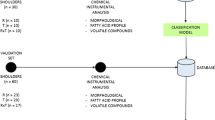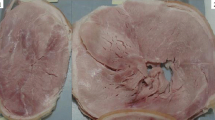Abstract
Iberian pigs are an autochthonous porcine breed exclusively from the south western of Iberian Peninsula. In this study, the main objective was to classify dry-cured Iberian shoulders from pigs with different diets. Thus, morphology, physico-chemical and sensory parameters, fatty acid profile and volatile compounds were determined. From this data, two datasets were created, for training and validation purpose. Results on this study, firstly demonstrate the capability of data mining techniques to classify shoulder as function of their different diets by using different chemical-instrumental-sensory parameters. Different classification models were tested in the training datasets. After that, all classification models were performed in the validation datasets and the model of J48 decision tree and fatty acid profile reached the best results (Sensitivity and Specificity > 0.750). From this classification model, a software application was developed for determining the diet of the Iberian pigs. This application could be used for the meat industries and inspection agencies.




Similar content being viewed by others
Abbreviations
- FA:
-
Fatty acids
- MUFA:
-
Mono-unsaturated fatty acids
- KDD:
-
Knowledge discovery in databases
- 100AG:
-
Diet based on acorn and grass 100%
- 75AG:
-
Diet based on acorn and grass 75% and feed 25%
- 50AG:
-
Diet based on acorn and grass 50% and feed 50%
- 25AG:
-
Diet based on acorn and grass 25% and feed 75%
- 0AG:
-
Diet based on feed 100%
- GC-FID:
-
Gas chromatography flame ionisation detector
- SPME:
-
Solid phase micro extraction
- GC–MS:
-
Gas chromatography mass spectrometry
- SENS:
-
Sensitivity
- SPEC:
-
Specificity
- TBARS:
-
Thiobarbituric acid-reactive substance
- TEP:
-
Tetraethoxypropane
- MDA:
-
Malonaldehyde
- FAME:
-
Fatty acid methyl esters
- HS:
-
Headspace
- LRI:
-
Linear retention indexes
- AU:
-
Area units
- WEKA:
-
Waikato environment for knowledge analysis
- DT:
-
Decision tree
- CAL:
-
Calibration
- VAL:
-
Validation
- TP:
-
True positive
- TN:
-
True negative
- FP:
-
False positive
- FN:
-
False negative
- ANOVA:
-
Analysis of variance
- SFA:
-
Saturated fatty acids
- PUFA:
-
Poly-unsaturated fatty acids
- LDA:
-
Lateral discrimination analysis
- RF:
-
Random forest
- K-NN:
-
K-nearest neighbours
- RBS:
-
Rules based systems
- ANN:
-
Artificial neural networks
References
R. Cava, J. Ventanas, J. Ruiz, A.I. Andrés, T. Antequera, Sensory characteristics of Iberian ham: influence of rearing system and muscle location. Food Sci. Techol. Int. 6, 235–242 (2000)
S. Ventanas, J. Ventanas, J. Ruiz, M. Estévez, Iberian pigs for the development of high quality cured products, in Recent Research in Development in Agricultural and Food Chemistry, ed. by S.G. Paraday (Research Singpost, Trivandrum, 2005), pp. 27–53
J. Ruiz, J. Ventanas, R. Cava, M.L. Timón, C. Garcia, Sensory characteristics of Iberian ham: influence of processing time and slice location. Food Res. Int. 31, 53–58 (1998)
J. Ruiz, C. Garcia, E. Muriel, A.I. Andrés, J. Ventanas, Influence of sensory characteristics on the acceptability of dry-cured ham. Meat Sci. 61, 347–354 (2002)
A.V.A. Resurreción, Sensory aspects of consumer choices for meat and meat products. Meat Sci. 66, 11–20 (2004)
G. Gandermer, Lipids in muscles and adipose tissues changes during processing and sensory properties of meat products. Meat Sci. 62, 309–321 (2002)
E. Muriel, J. Ruiz, J. Ventanas, M.J. Petrón, T. Antequera, Meat quality characteristics in different lines of Iberian pigs. Meat Sci. 67, 299–307 (2004)
J.F. Tejeda, G. Gandermer, T. Antequera, M. Viau, C. Garcia, Lipid traits of muscles as related to genotype and fattening diet in Iberian pigs: total intramuscular lipids and triacyglycerols. Meat Sci. 60, 357–363 (2002)
T. Pérez-Palacios, T. Antequera, M.L. Durán, A. Caro, P.G. Rodríguez, J. Ruiz, MRI-based analysis, lipid composition and sensory traits for studying Iberian dry-cured hams from pigs fed with different diets. Food Res. Int. 43, 248–254 (2010)
D. Caballero, M. Asensio, C. Fernández, N. Martín, A. Silva, Classifying different Iberian pig genetic lines by applying chemical-instrumental parameters of dry-cured Iberian shoulders. J. Food Sci. Technol. 55, 4589–4599 (2018)
D.S. Mottram, Flavour information in meat and meat products: a review. Food Chem. 62, 415–424 (1998)
D. Machielis, L. Istasse, Solid-phase microextraction evaluation of key aroma compounds in cooked beef meat as influenced by breed and diet. in 48th International Congress on Meat Science and Technology (ICOMST). (Rome, 2002)
L. Martin, J.J. Córdoba, T. Antequera, M.L. Timón, J. Ventanas, Effects of salt and temperature on proteolysis during ripening of Iberian ham. Meat Sci. 49, 145–153 (1998)
F. Toldrá, M. Flores, Y. Sanz, Dry-cured ham flavour: enzymatic generation and process influence. Food Chem. 59, 523–530 (1997)
A. Silva, R. Reina, J. García-Casco, J. Ventanas, Chemical-instrumental-sensory parameters and chemometrics as tools to discriminate among the quality categories of dry-cured Iberian shoulder. Grasas Aceites 64(2), 201–209 (2013)
U. Fayyad, G. Piatetsky-Shapiro, P. Smyth, From data mining to knowledge discovery in databases. AI Mag. 17, 37–54 (1996)
S. Sayad, Real Time Data Mining (Self-Help Publishers, Cambridge, 2011)
B.L. Batista, L.R.S. Da Silva, B.A. Rocha, J.L. Rodrigues, A.A. Beretta-Silva, T.O. Bonates, V.S.D. Gomes, R.M. Barbosa, F. Barbosa, Multi-element determination in Brazilian honey samples by inductively coupled mass spectrometry and estimation of geographic origin with data mining techniques. Food Res. Int. 29, 209–215 (2012)
T. Pérez-Palacios, D. Caballero, S. Bravo, J. Mir-Bel, T. Antequera, Effect of cooking conditions on quality characteristics of confit cod: prediction by MRI. Int. J. Food Eng. 13(8), 20160311 (2017)
G. Holmes, D. Fletcher, P. Reutermann, An application of data mining to fruit and vegetable sample identification using gas chromatography-mass spectrometry. in X International Congress on Environmental Modeling and Software Managing Resources of a Limited Planet. (Leipzig, 2012)
D. Caballero, A. Caro, P.G. Rodríguez, M.L. Durán, M.M. Ávila, R. Palacios, T. Antequera, T. Pérez-Palacios, Modeling salt diffusion in Iberian ham by applying MRI and data mining. J. Food Eng. 189, 115–122 (2016)
T. Pérez-Palacios, T. Antequera, M.L. Durán, A. Caro, P.G. Rodríguez, R. Palacios, MRI-based analysis of feeding background effect on fresh Iberian ham. Food Chem. 126, 1366–1372 (2011)
J. Folch, M. Lees, G.H. Sloane-Stanley, A simple method for the isolation and purification of total lipids from animal tissues. J. Biol. Chem. 226(1), 497–509 (1957)
Association of Official Analytical Chemistry (AOAC), Official Methods of Analysis of AOAC International. Vols. 1 and 2, 17th edn. (AOAC International, Gaithersburg, 2000)
H.C. Hornsey, The color of cooked cured pork. Estimation of the nitric oxide-haem pigments. J. Sci. Food Agric. 7, 534–541 (1956)
A.M. Salih, D.M. Smith, J.F. Price, L.E. Dawson, Modified extraction 2-thibarbituric acid method for measuring lipid oxidation in poultry. Poult. Sci. 66, 1483–1488 (1987)
S.R. Sandler, W. Karo (eds.), Source Book of Advanced Organic Laboratory Preparations (Academic Press, San Diego, 1992)
S. Ventanas, J. Ventanas, J. Tovar, C. García, M. Estévez, Extensive feeding versus oleic acid and tocopherol enriched mixed diets for the production of Iberian dry-cured hams: effect on chemical composition, oxidative status and sensory traits. Meat Sci. 77, 246–256 (2007)
C. Garcia, J. Ventanas, T. Antequera, J. Ruiz, R. Cava, P. Álvarez, Measuring sensory quality of Iberian ham by Rasch model. J. Food Qual. 19, 397–412 (1996)
H. Stone, J. Sidel, S. Oliver, A. Woolsey, R.C. Singleton, Sensory evaluation by quantitative descriptive analysis. Food Tech. 28, 24–34 (1974)
S. Drazin, M. Montag, Decision Tree Analysis Using WEKA. Machine Learning-Project II (University of Miami, Miami, 2012)
R. Safavian, D. Landgrebe, A survey of decision tree classifier methodology. IEEE Trans. Syst. Man Cybern. 21(3), 660–674 (1991)
J.R. Quinlan (ed.), C4.5.: Programs for Machine Learning (Morgan Kaufmann Publishers, San Francisco, 1993)
M.N. Anyanwu, S.G. Shiva, Comparative analysis of serial decision tree classification algorithms. Int. J. Comput. Sci. Secur. (IJCSS) 3, 230–240 (2009)
A. Priyam, G.R. Abhijeeta, A. Rathee, S. Srivatstava, Comparative analysis of decision tree classification algorithms. Int. J. Curr. Eng. Technol. (IJCET) 3(2), 334–337 (2013)
J. Demsar, Statistical comparisons of classifier over multiple data sets. J. Mach. Learn. Res. 7, 1–30 (2006)
D.J. Hand, Assessing the performance of classification methods. Int. Stat. Rev. 80, 400–414 (2012)
R. Reina, P. López-Buesa, J. Sánchez del Pulgar, J. Ventanas, C. García, Effect of IGF-II (insulin-like growth factor-II) genotype on the quality of dry-cured hams and shoulders. Meat Sci. 92, 562–568 (2012)
A.I. Andrés, S. Ventanas, J. Ventanas, R. Cava, J. Ruiz, Physico-chemical changes throughout the ripening of dry-cured hams with different salt content and processing conditions. Eur. Food Res. Technol. 221, 30–35 (2005)
J.J. Córdoba, E. Aranda, J.M. Benito, Alteraciones originadas por microorganismos, ácaros e insectos en jamones Ibéricos, in Tecnología del Jamón Ibérico, ed. by J. Ventanas (Mundi-Prensa, Madrid, 2001), pp. 465–488
J. Ventanas, Jamón ibérico y Serrano: Fundamentos de la elaboración y la calidad (Mundi-Prensa, Madrid, 2012)
C.M. Rosell, F. Toldrá, Effect of curing agent on m-calpain activity throuhgout the curing process. Eur. Food Res. Technol. 203(4), 320–325 (1996)
E. Muriel, T. Antequera, J. Ruiz, Utilización de piensos con elevado contenido en ácido oleico. Influencia sobre la composición de la grasa intramuscular en cerdos Ibéricos. Eurocarne 103, 179–190 (2002)
C. García, J.J. Berdagué, T. Antequera, C.J. López-Bote, J.J. Córdoba, J. Ventanas, Volatile components of dry-cured Iberian ham. Food Chem. 41, 23–32 (1991)
I.L. Hinrichsen, H.J. Andersen, Volatile compounds and chemical changes in cured pork: role of three halotolerant bacteria. J. Agric. Food Chem. 42, 1537–1542 (1994)
E. Cernadas, M. Fernández-Delgado, E. González-Rufino, P. Carrión, Influence of normalization and color space to color texture classification. Pattern Recognit. 61, 120–138 (2017)
M. Fernández-Delgado, E. Cernadas, S. Barro, D. Amorim, Do we need hundreds of classifiers to solve real world classification problems? J. Mach. Learn. Res. 15, 3133–3181 (2014)
A.P. Hearty, M.J. Gibney, Analysis of meal patterns with use of supervised data mining techniques—artificial neural networks and decision trees. Am. J. Clin. Nutr. 88, 1632–1642 (2008)
J. Fernández, I. Clemente, C. Amador, A. Membrillo, P. Azor, A. Molina, Use of different sources of information for the recovery and genetic management of endagered populations: example with the extreme case of Iberian pig Dorado strain. Livest. Sci. 149, 282–288 (2012)
Ministerio de Agricultura, Pesca, Alimentación y Medio Ambiente (MAPAMA). Datos de las denominaciones de origen protegidas (D.O.P.), Indicaciones geográficas protegidas (I.G.P.) y Especialidades Tradicionales Garantizadas (E.T.G.) de Productos Agroalimentarios. Madrid, Spain: Centro de Publicaciones del MAPAMA. (2016)
M.A. Sentandreu, E. Sentandreu, Authenticity of meat products: tools against fraud. Food Res. Int. 60, 19–29 (2014)
N.Z. Ballin, Authentication of meat and meat products. Meat Sci. 86(3), 577–587 (2010)
Acknowledgements
Daniel Caballero thanks the “Junta de Extremadura” for the post-doctoral Grant (PO17017).
Author information
Authors and Affiliations
Corresponding author
Additional information
Publisher's Note
Springer Nature remains neutral with regard to jurisdictional claims in published maps and institutional affiliations.
Rights and permissions
About this article
Cite this article
Caballero, D., Asensio, M., Fernández, C. et al. Chemical-instrumental-sensory traits and data mining for classifying dry-cured Iberian shoulders from pigs with different diets. Food Measure 13, 2935–2950 (2019). https://doi.org/10.1007/s11694-019-00214-4
Received:
Accepted:
Published:
Issue Date:
DOI: https://doi.org/10.1007/s11694-019-00214-4




